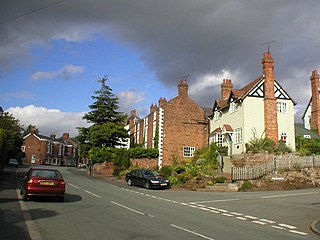
Farndon is a village and civil parish in the unitary authority of Cheshire West and Chester and the ceremonial county of Cheshire, England. It is on the banks of the River Dee, south of Chester, which here forms the England–Wales border. The Welsh town of Holt lies just over the River Dee from Farndon.

Flintshire is a county in the north-east of Wales. It borders England to the east, Denbighshire to the west and Wrexham County Borough to the south. It is named after the historic county of the same name which has notably different borders. Flintshire is considered part of the Welsh Marches and formed part of the historic Earldom of Chester and Flint. The county is governed by Flintshire County Council which has its main offices in County Hall, Mold.
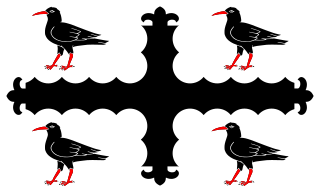
Flintshire, also known as the County of Flint, is one of Wales' thirteen historic counties, and a former administrative county. It mostly lies on the north-east coast of Wales.
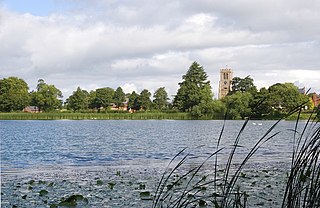
Sir David Hanmer, KS, SL (c.1332–1387) was a fourteenth century Anglo-Welsh Justice of the King's Bench from Hanmer, Wales, best known as Owain Glyndŵr's father-in-law and the father of Glyndŵr's chief supporters.
The Maelor is an area of north-east Wales along the border with England. It is now entirely part of Wrexham County Borough.

English Maelor comprises one half of the Maelor region on the Welsh side of the Wales-England border, being the area of the Maelor east of the River Dee. The region has changed counties several times, previously being part of Cheshire and later a detached portion of Flintshire. The area is currently in Wales, despite its name, and administered as part of Wrexham County Borough.

Overton or Overton-on-Dee is a village and community in Wrexham County Borough, Wales. It is situated close to the Welsh-English border on the edge of an escarpment that winds its way around the course of the River Dee, from which Overton-on-Dee derives its name.
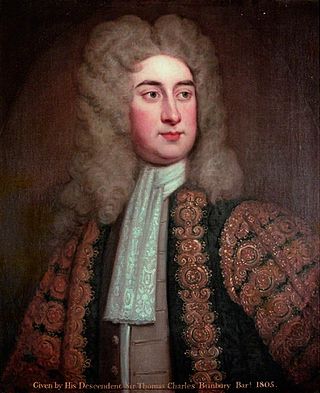
Sir Thomas Hanmer, 4th Baronet was Speaker of the House of Commons of Great Britain from 1714 to 1715, discharging the duties of the office with conspicuous impartiality. His second marriage was the subject of much gossip as his wife eloped with his cousin Thomas Hervey and lived openly with him for the rest of her days. He is, however, perhaps best remembered as being one of the early editors of the works of William Shakespeare.
Maelor was a rural district in the administrative county of Flintshire, Wales, from 1894 to 1974. The area approximated to the hundred of Maelor or English Maelor, and was notable for forming a detached part of the county, surrounded by Cheshire, Denbighshire and Shropshire. The administrative centre was located at Overton.

Hope is a small village and community in Flintshire, north-east Wales. The village is located approximately 3 miles / 4.5 km from the Wales-England border, on the course of the River Alyn, and less than 5 miles from Wrexham.

Erbistock is a village and community in Wrexham County Borough, Wales. The village lies on the banks of the River Dee.
This is a list of High Sheriffs of Flintshire.
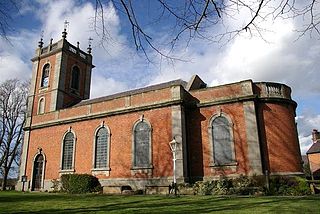
Willington Worthenbury is a community in Wrexham County Borough, Wales, and is situated near the England–Wales border.
Overton Rural District was formed by the Local Government Act 1894 which created numerous administrative areas around the country. The district was located in an exclave of Flintshire known as English Maelor, surrounded by Cheshire, Denbighshire and Shropshire.

Maelor South is a community in the area of Maelor Saesneg, Wrexham County Borough, Wales. It contains the villages of Penley and Bettisfield along with a number of other small hamlets and is represented by the Maelor South Community Council. At the time of the 2001 census, the community area had a total population of 1,137 people, increasing to 1,268 at the 2011 Census.

In the United Kingdom, the term listed building refers to a building or other structure officially designated as being of special architectural, historical, or cultural significance; Grade II* structures are those considered to be "particularly important buildings of more than special interest". Listing was begun by a provision in the Town and Country Planning Act 1947. Once listed, strict limitations are imposed on the modifications allowed to a building's structure or fittings. In Wales, the authority for listing under the Planning Act 1990 rests with Cadw.
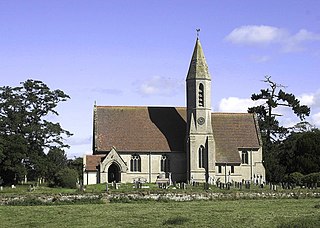
Bettisfield is a village of about 150 dwellings in Wrexham County Borough, Wales and stands on the Wales-England border, and in the community of Maelor South. It lies south of the Llangollen Canal on the border with Shropshire, England within the historic English Maelor region which was formerly part of the historic county of Flintshire. The village lies close to Fenn's, Whixall and Bettisfield Mosses, an area of peat bog which was declared a national nature reserve in 1996 because of its importance for wildlife. The English market towns of Whitchurch, Ellesmere and Wem each lie about 6 miles distant to the northeast, west and southeast respectively.

Whitewell is a dispersed rural settlement, and surrounding ecclesiastical parish, in the east of Wrexham County Borough, Wales.
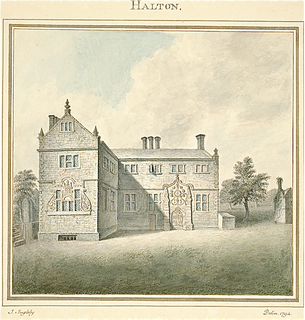
Halghton is a dispersed settlement and former civil parish in the east of Wrexham County Borough, Wales. It is part of the community of Hanmer.
This article is about the particular significance of the year 1701 to Wales and its people.



















